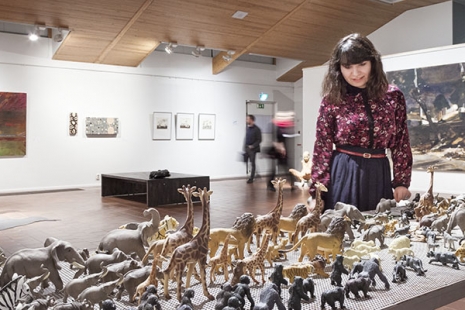In the Korundi Exhibition, the stellar nebula illuminates the path of the visitor. The works in the exhibition make remarks on the mysteries of astronomy, humanity and art. The works lead to reflection on how everything originated and how diverse life is on our planet.
The exhibition is named after Petri Eskelinen’s work Landing Place in 2014. The work of Eskelinen, A Rovaniemi native, greets Osmo Valtonen’s popular Ellipsography from 1988, which is permanently on display in the museum.
Niels Haukeland’s Seven Shadows (1995) in the white hall is reminiscent of a black hole, a mass concentration of space-time from which nothing can escape. In Kari Cavén’s work, Movables, chairs are hovering against the laws of gravity, and in which even thoughts seem to escape.
Tuula Lehtinen’s work Coronation II: Queen Charlotte (2021) takes the viewer as a gatecrasher at the Queen’s coronation, behind curtains. The baroque-like heavy pleats skillfully depicted by Lehtinen turn into stunning color streaks on the canvas of the painting at the speed of light. Heikki Kukkonen’s Hot Wind (1995) glows like the surface of the planet Mars.
Fragile Identity 7 (2016) transforms the graffiti artist EGS’s artist name into glowing white three-dimensional objects. The delicate material of the three-part glass work creates the opposite impression: the work feels durable and energetic as the spray paint in an aerosol can.
The blue hall in all its strangeness is playful. The sand flows wildly in the pipelines in Heini Aho’s work Fools Time I (2020) and Emma Helle’s Ça Tombe Bien (2018) a sculpture in which a flower girl seems to make a somersault under a big shimmering hand, which is Pekka Jylhä’s work Apparition (1996). Noora Schroderus’ Small Scale Sculpture (2008) is larger than life. A man stands in his overalls as the crown of creation on top of a structure and takes over the world.





